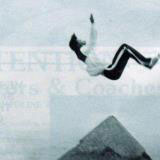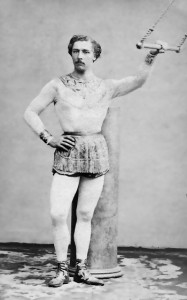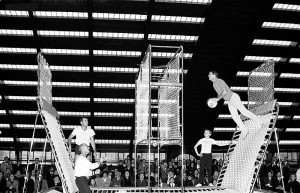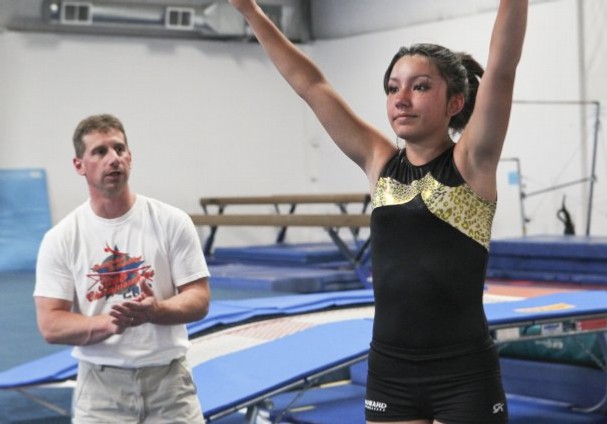 Some fourty+ years ago George Nissen, George Hery, and Ron Munn were on a promotional trampoline tour through Egypt. They carried a mini-trampoline to the top of the Great Pyramid on the Giza plateau and became the first, and only known, persons to perform a back flip on the top of the Great Pyramid.
Some fourty+ years ago George Nissen, George Hery, and Ron Munn were on a promotional trampoline tour through Egypt. They carried a mini-trampoline to the top of the Great Pyramid on the Giza plateau and became the first, and only known, persons to perform a back flip on the top of the Great Pyramid.
Trivia Question March: Can you name the persons whom have done a back flip at the top of the Great Pyramid in Giza?
Trivia Question February 2013: What year did the trampoline become an Olympic event?
Olympic Trampoline History
Trampolining, while widely popular since its invention in 1934, did not become an Olympic sport until the 2000 Olympic games in Sydney, Australia. That year men and women’s trampoline competition were introduced. Trampoline competition is classified under gymnastics for the Olympics and is performed in the same venue as the gymnastic competitions.
Trivia Question: Who invented the trampoline?
The first modern trampoline was built by George Nissen and Larry Griswold in 1936. Nissen was a gymnastics and diving competitor and Griswold was a tumbler on the gymnastics team, both at the University of Iowa, USA. They had observed trapeze artists using a tight net to add entertainment value to their performance and experimented by stretching a piece of canvas, in which they had inserted grommets along each side, to an angle iron frame by means of coiled springs. It was initially used to train tumblers but soon became popular in its own right. Nissen explained that the name came from the Spanish trampolín, meaning a diving board. George Nissen had heard the word on a demonstration tour in Mexico in the late 1930s and decided to use an anglicized form as the trademark for the apparatus.
In 1942, Griswold and Nissen created the Griswold-Nissen Trampoline & Tumbling Company, and began making trampolines commercially in Cedar Rapids, Iowa.
The generic term for the trademarked trampoline was a rebound tumbler and the sport began as rebound tumbling. It has since lost its trademark and has become a generic trademark.
1968 demonstration of Spaceball.
Early in their development Nissen anticipated trampolines being used in a number of recreational areas, including those involving more than one participant on the same trampoline. One such game was Spaceball—a game of two teams of two on a single trampoline with specially constructed end “walls” and a middle “wall” through which a ball could be propelled to hit a target on the other sides end wall.
Use in flight and astronaut training
During World War II, the United States Navy Flight School developed the use of the trampoline in its training of pilots and navigators, giving them concentrated practice in spatial orientation that had not been possible before. After the war, the development of the space flight programme again brought the trampoline into use to help train both American and Soviet astronauts, giving them experience of variable body positions in flight.
Competitive sports
One of the earliest pioneers of trampoline as a competitive sport was Jeff Hennessy, a coach at the University of Louisiana at Lafayette. Hennessy also coached the United States trampoline team, producing more world champions than any other person. Among his world champions was his daughter,Leigh Hennessy. Both Jeff and Leigh Hennessy are in the USA Gymnastics Hall of Fame.
The competitive gymnastic sport of trampolining has been part of the Olympic Games since 2000. On a modern competitive trampoline, a skilled athlete can bounce to a height of up to 10 metres (33 ft), performing multiple somersaults and twists. Trampolines also feature in the competitive sport of Slamball, a variant of basketball, and Bossaball, a variant of volleyball.
Cross-training for other sports
There are a number of other sports that use trampolines to help develop and hone acrobatic skills in training before they are used in the actual sporting venue. Examples can be found in diving, gymnastics, and freestyle skiing.
Trivia Question: Who is the leotard named after?
 The leotard came into existence in the 1880s. It was named after a young French acrobat called Jules Léotard, who invented the flying trapeze act by stringing some swings over his father’s swimming pool. Léotard performed in a tight, self-designed one-piece costume. Unsurprisingly, his scantily dressed flying act was immensely popular with the tightly-corseted young ladies of Victorian England. His notoriety as a lover was sealed when George Leybourne wrote a hit music hall song entitled The Daring Young Man on the Flying Trapeze:
The leotard came into existence in the 1880s. It was named after a young French acrobat called Jules Léotard, who invented the flying trapeze act by stringing some swings over his father’s swimming pool. Léotard performed in a tight, self-designed one-piece costume. Unsurprisingly, his scantily dressed flying act was immensely popular with the tightly-corseted young ladies of Victorian England. His notoriety as a lover was sealed when George Leybourne wrote a hit music hall song entitled The Daring Young Man on the Flying Trapeze:
Oh, he floats through the air
With the greatest of ease,
This daring young man
On the flying trapeze;
His actions are graceful,
All girls he does please,
My love he has purloined away!
Sadly, reality failed to live up to the legend. Jules died at the tender age of 30, probably from smallpox, just as the term ‘leotard’ was gaining popular currency. Had he been alive to trademark his scandalous gym wear, he might well have ended up swinging from the rooftops of the largest banks in Europe.
Welcome to our New Website!
Please bear with us as we finalize it. Please take a moment to look around and please let us know what you think!
Check back for new and updated information.
Rising stars raising the bar Five local gymnasts set sights on national spotlight in Texas
When people think of gymnastics, they tend to think of the artistic variety: the balance beams, uneven bars and the vault.
But other forms of gymnastics — trampoline and tumbling — have evolved into Olympic sports.
The place to go for trampolinists and tumblers in the local area is G-Force Gymnastics in Redding.
Five members of G-Force Gymnastics are headed to this year’s Trampoline & Tumbling Junior Olympic National Championships in San Antonio, on July 9-15.
Read the rest of this article at the Redding Record Searchlight website.



